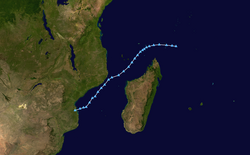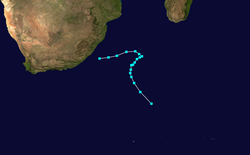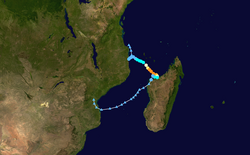08R 2014 track
Storm type
Relevante Bilder
Relevante Artikel
Zyklonsaison im Südwestindik 2013–2014Die Zyklonsaison im Südwestindik 2013–2014 begann offiziell am 15. November 2013 und endete am 30. April 2014, mit Ausnahme von Mauritius und den Seychellen, wo sie erst am 15. Mai 2014 endete. Diese Daten begrenzen konventionell die Zeit des meteorologischen Jahres der Südhalbkugel, in denen sich im südwestlichen Indik die meisten tropischen Wirbelstürme bilden. Das erste tropische System bildete sich aber bereits am 8. Juli 2013. Die tropischen Wirbelstürme in diesem Becken werden durch das Regional Specialized Meteorological Centre (RSMC) in La Réunion, Frankreich überwacht. Das Verantwortungsgebiet von Météo-France umfasst den Indischen Ozean südlich des Äquators und westlich von 90° östlicher Länge. Tropische Wirbelstürme in diesem Bereich werden Zyklone genannt. Das Joint Typhoon Warning Center (JTWC) in Honolulu beobachtet ebenfalls das Wettergeschehen in diesem Seegebiet; es gibt Sturmwarnungen aus, die sich primär an Einrichtungen der Streitkräfte der Vereinigten Staaten im Indischen Ozean richten. .. weiterlesen
































